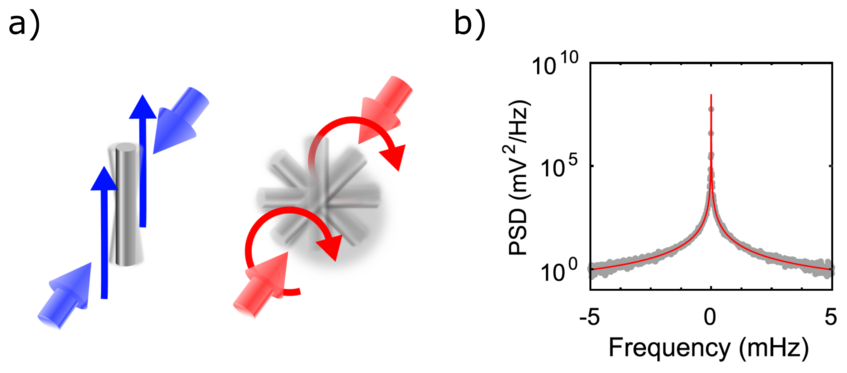Rotational Optomechanics

The primary aim of the Quantum Nanophysics group is to test for limits of the quantum superposition principle. As we work with larger and larger particles, their structure becomes increasingly complex. As explained in the Cavity Cooling section, we can control the motion of silicon nanoparticles by using an optical cavity, which will enable us to generate a coherent source of particles for matter-wave
Previously, we were only considering the centre-of-mass motion of our nanoparticles, but these large particles also have rotational degrees of freedom. We can nanofabricate silicon nanorods, and launch them through our optical cavity [1]. By doing this, we observe the nanorods rotating at frequencies up to 50MHz, the fastest spinning man made object!
Levitation and control of nanorods
If we wish to perform sensitive quantum experiments, we need to be able to control this rotational motion. To understand the interaction between light and the nanorods, we levitate them in a standing light wave. Elongated particles align with the polarization vector of the light, and through this method we can trap, align and even spin the levitated nanoparticles [2].

We can lock the rotation of the nanorod to an external signal, by modulating the polarization of the trapping light [3]. Amazingly, for a wide range of parameters, the locking is so good that the rotation is no longer adversely effected by environmental effects such as gas pressure or laser noise. This leads to an extremely high frequency purity; rotation rates of 1MHz have a linewidth of 1μHz at the relatively high pressures of a few milliBar.
This work on levitation and control of nanofabricated particles is extremely useful for force-sensing [4], and our detailed understanding of rotational dynamics informs future experiments on the quantum physics of rotation.
Ro-translational cavity cooling
Will it be possible to control rotation well enough that we can use rod-shaped particles for matter-wave interferometry? The interaction of the alignment of nanorods with the polarization vector of an optical cavity field leads to cooling of rotation, similar to the ability to cavity cool the centre-of-mass motion. We predict that it should be possible to cavity cool both the translational and rotational motion of silicon nanorods to the quantum ground state [5], and test rotational decoherence mechanisms. Quantum control of both the position and alignment of nanoparticles is essential for future tests of quantum physics on the nanoscale.
References
[1] Kuhn, Asenbaum, Kosloff, Sclafani, Stickler, Nimmrichter, Hornberger, Cheshnovsky, Patolsky, and Arndt
Cavity-Assisted Manipulation of Freely Rotating Silicon Nanorods in High Vacuum.'
Nano Letters 15, 5604 (2015)
[2] Kuhn, Kosloff, Stickler, Patolsky, Hornberger, Arndt, and Millen
Full Rotational Control of Levitated Silicon Nanorods
Optica 4(3), 356-360 (2017)
[3] Kuhn S, Stickler BA, Kosloff A, Patolsky F, Hornberger K, Arndt M, et al.
Optically driven ultra-stable nanomechanical rotor.
Nature Communications. (2017) 8(1):1670.
[4] Patent filed
[5] Stickler, Nimmrichter, Martinetz, Kuhn, Arndt and Hornberger
Rotranslational cavity cooling of dielectric rods and disks.
Phys. Rev. A 94, 033818 (2016)
[6] Stickler, Papendell and Hornberger
Spatio-orientational decoherence of nanoparticles.
Phys. Rev. A 94, 033828 (2016)
[6] Stickler BA, Papendell B, Kuhn S, Millen J, Arndt M, Hornberger K.
Orientational quantum revivals of nanoscale rotors.
arXiv:180301778v1 (2018).
